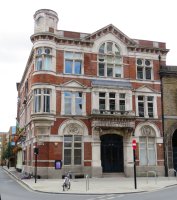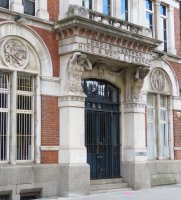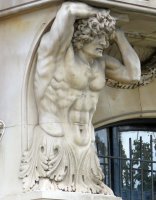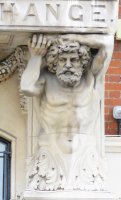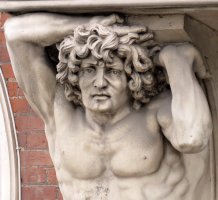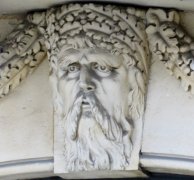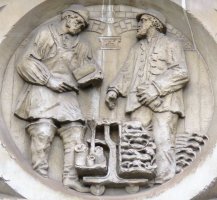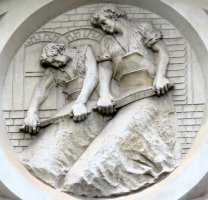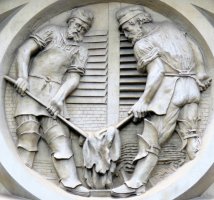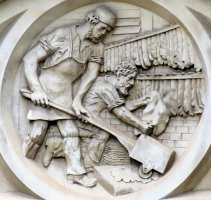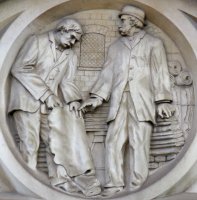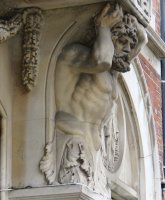London Leather Exchange, Leathermarket Street/Weston Street, Bermondsey
A Victorian commercial building with architectural carving: roundels with carvings in high relief showing pairs of workmen tanning leather, and a fine door with supporting Atlantes.
London Leather Exchange, George Elkington architect.
The London Leather, Hide and Wool Exchange, to give its full title, stands in Weston Street, Southwark, a little walk from the main road. It occupies a corner site, with a flat-topped turret to the corner which once held a clock. The principal frontage has three bays, the centremost with the imposing entrance, and carved roundels above the ground floor windows to either side; there is no significant carving above the ground floor. Round the corner in Leathermarket, we have three further bays with carved roundels, so five in all, and the building carries on, incorporating a pub.
The portico.
The building is faced with red brick, terra cotta and Portland Stone, in a Queen Anne style, which became popular in the latter Victorian era, always with the red and white contrasts, and a mix of elements, including here pedimented windows to the first floor, pilasters [flat pillars] to the other, round and flat-headed windows, rather renaissance banding at the top, and that round corner turret which could have been inspired by a Wren or Hawksmoor church. The proportions are excellent. It was designed in 1878 by the architect George Elkington (1830-1900), not to be confused with George Richard Elkington of Birmingham, the famous silversmiths and electroplating firm.
the Atlantes figures.
The portico first. The frontage centres on this doorway, supporting a heavy stone balcony to a projecting first floor window, with a raised pediment above a round-headed window to the upper storey. The balcony is supported on a pair of projected Atlantes, male figures or, as here, half figures, the less-usual male form of caryatids. They are suitably muscular, outer arm raised above the bowed head, inner arm towards the door with projecting elbow and upturned palm. They are Classical in a Renaissance style, with exaggerated musculature and a rather tortured face to the figure on the left as we look at the door. For half figures, there is always the question as to what to do where the body, here about waist-height, becomes the plain supporting pillar, and here it is with a skirting of Acanthus leaves sitting on top of a square capital; similar leafy designs are sometimes used at the waist of a mermaid to make the transition from girl to fish. The poses are more visually than anatomically satisfying: hold your arms in that position and you will find it not entirely as you would support a heavy load, and those arms have to be a little short for the bodies to fit in their allocated spaces without looking aesthetically unpleasing or leave a projecting elbow to suffer from the weather. The Atlante to the left is more youthful, a beardless Apollo-style personage, with twisting locks of hair, while he to the right is a bearded figure. Well carved, with a degree of expression, and there are rather few such figures in England (a notable City of London one is at Drapers Hall, Throgmorton Street), so to be appreciated - some more are on this page.
Within the doorway under the balcony, which bears the name of the building, are carved festoons of leaves, with a central keystone. This is carved as a heavily moustached and bearded man, with the beard clipped square at the base, for this is quite a short keystone, and with oak leaves and acorns in his hair, to match the festoons to either side. This keystone is likely from some different carver than the Atlantes, a competent but rather bland piece. Lots more on keystones on this page. Now to the roundels. Each shows a pair of figures, at some stage in the industry of leather preparation. The designs are well conceived, with bold lines to create a harmonious effect, and the figures 'too large for their frames' in medieval style, to focus on their activity rather than the overall scene, and give maximum impact in what is a fairly small space, raised up above the viewer. They are read from the left, thus starting round the building to the side.
Weighing hides.
First we have a pair of figures, weighing out hides on a wheeled scale, still with what seem to be horned heads attached – it is rather worn to tell. The figure to the left wears a works overall, and carries a book where he is presumably writing the weight; the better-dressed figure to the right would likely be the seller of hides.
Scraping and dipping.
Next is scraping of the hides: the two workmen pulling scrapers towards their bodies, the hides over their legs; one wears a sleeveless shirt, the other has sleeves rolled up, and both with thick protecting aprons. They are posed like a pair of oarsmen, so all the focus is on their hands and the scrapers. Next, we see a more symmetrical composition: a pair of workmen dipping skins into a tanning pit before laying them on a heap behind; each wears a stout apron belted at the waist, and thick greaves to the legs. To give variety to the composition, one workman is seen from the front, the other from the back.
Rolling and flattening.
Round to the front of the building, to the left of the portico, the fourth roundel shows a workman running a roller over a skin, to squeeze out the liquid from the skin and flatten it; his mate behind is hanging up the skins from two racks, to dry out. The composition here is focused on the pressing tool; note the radiating lines of the design from that tool to the front man's shoe, another along the handle, a third along the rear fellow's arm, and a fourth through the two heads; a vertical line runs through the hands holding a skin up to the frame to the wall behind.
Inspection.
The final roundel, to the right of the portico, shows two suited men, one examining a skin, the other perhaps directing him, and batches of rolled and stacked skins behind, for release from the workshop on to their destination.
Altogether, a good group, illustrative rather than subtle, better in the composition, which was perhaps by Elkington, than in the execution, which has some weaknesses in the proportions and particularly the arms, but is fair to good in general and with some nicely caught aspects. As ever, the effects of time and erosion mean that we may not be looking at quite what the carver wrought. Unfortunately, I do not have information on the sculptor or sculptors who worked on this building.
A final word on the fate of the building: the leather industry had been important to Bermondsey since before Victorian times, with leather trading from around 1830, and at the time the building was put up was at a peak, however this began to decline, and the Exchange building became first more of a club for leather tradesmen, and then by 1900 the less glamorous trading office. Today it seems to be offices, plus the pub.
There are a variety of good things of sculptural interest nearby:
Go northwards to another decorated building, Keats House; west to Borough High Street and Trinity Square; or south east to St Mary Magdalene, with its monuments. See also the page Borough to Bermondsey.
